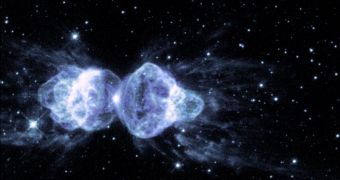Planetary nebulae have been first discovered some three centuries ago, but the astronomers of the time, being unable to clearly identify them, named nebulae by attributing them the name of "planetary", mostly because they seemed to have some resemblance to the planet Uranus. In the middle of the 19th century astronomers finally realized what the strange objects really are, not planets but massive clouds of gas and dust surrounding the volume around a star in its final stages of life.
We've mostly associated the name of planetary nebula with the possible existence of a planet in the large debris cloud, but no planets have ever been found around a dying star within a planetary nebula. Now University of Rochester researchers announced that they might have been able to find some link between planetary nebulae and low-mass stars orbited by gas giants, such as Jupiter. Large planets orbiting around low-mass stars could have greatly influenced the appearance of planetary nebulae, as we see them today.
Studying the processes which take place in the case of the presence of a large star around a low-mass star, astronomer and professor of physics and astronomy at the University of Rochester, Eric Blackman observes: "Few researchers have explored how something as small as a very low-mass star, as brown dwarf, or even a massive planet can produce several flavors of nebulae and even change the chemical composition of the dust around these evolved stars."
Blackman writes that the vast majority of stars such as our Sun live most of their lives inside planetary nebulae. At the end of their lives, a stage which usually requires about a few thousand years, hydrogen fuel starts to become ever scarce. To compensate, the star starts to burn heavier elements, contracting the core and expanding the outer layers as much as a few million kilometers into space, practically becoming what we call a red giant. Not only that, but the envelope surrounding the core starts losing its original spherical shape, taking some of the weirdest shapes ever seen.
The Milky Way could contain more than 200 billion stars or so, but only 1,500 of these have been classified as planetary nebulae.
As the outer layers expand, they eventually encounter the inner planets with which they interact through gravitational forces, distorting the shape of the envelope while in large orbit or being totally engulfed by the star. Simulations show that, when the red giant is being orbited by a relatively large companion such as a gas giant or another star, the gravitational pull of the object would begin to accrete matter, basically constructing a spiral pattern of material around the star.
Eventually, the spiral of matter contract and create a torus of gas and dust above the equatorial regions of the star, preventing it from further expansion. "Richar Edgar discovered that as the spiral waves break, they release their compressed, pent-up energy in a burst of heat, sufficient to melt the dust into liquid globules," said Blackman.
The team showed that the distinctive torus of material around the star creates only a certain type of planetary nebulae. Additionally, Blackman set to model what actually happens when a high-mass planet is being engulfed by the expanding envelope of a low-mass star, and realized that three possible outcomes may occur in the process.
The planet could drag through the mass of the envelope material, only to be disintegrated and ejected into a torus shape along with some material from the stars outer layers.
Secondly, the planet of star companion skids across the outer layers relatively gently thus determining the acceleration of spin of the envelope in the respective region around the star, difference in rotation which boosts the magnetic field of the star and starts ejecting material through its poles.
The third and final possibility is that the planet is quickly disintegrated and ejected into space through matter ejection through the star's poles, but this process is only reserved for low-mass stellar companions of massive planets.
Nonetheless, none of the three possible outcomes will occur if the star's powerful gravitational pull disintegrates the planet long before it reaches the envelope, only to create a disk of debris around the red giant. Some regions of the field of debris would create powerful magnetic fields due to differential spin rates again resulting in massive ejection of matter through the poles. The Rochester research team now hopes to unlock the mysteries of what kind of magnetic interactions produce selective transportation of different chemical elements, to give planetary nebulae their distinctive chemical signatures.

 14 DAY TRIAL //
14 DAY TRIAL //